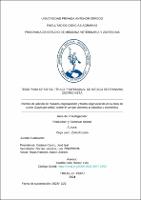Efectos de adición de manano-oligosacárido y fructo-oligosacárido en la dieta de cuyes (Cavia porcellus) sobre el comportamiento productivo y económico
Abstract
El presente estudio tuvo como objetivo de determinar el efecto de la adición del
manano-oligosacarido (MOS) y fructo-oligosacarido (FOS) en la dieta de cuyes
sobre su comportamiento productivo y económico. Se utilizaron 32 cuyes (16
machos y 16 hembras) destetados, los cuales fueron distribuidos a través de un
diseño de bloques completamente al azar, con 4 tratamientos: MF0 (dieta control),
MF10 (dieta con 10% de MOS y FOS), MF15 (dieta con 15% de MOS y FOS) y
MF20 (dieta con 20% MOS y FOS), ocho bloques con factor bloqueo de peso inicial
del cuy y una repetición. Se evaluaron los parámetros productivos: ganancia de
peso (g), consumo de alimento (g) y conversión alimenticia (kg/kg) en la fase de
inicio (15-30 días), crecimiento (31-60 días) y acabado (61-84 días), y el parámetro
económico: beneficio neto (s/). Los resultados fueron analizados mediante el
análisis de varianza y los promedios se compararon a través de la prueba de Tukey
(P<0.05). No se obtuvo diferencias significativas (P >0.05) en el comportamiento
productivo de las fases de crianzas The aim of the present study was to determine the effect of the addition of mannan
oligosaccharide (MOS) and fructo-oligosaccharide (FOS) in the diet of guinea pigs
on their productive and economic performance. Thirty-two weaned guinea pigs (16
males and 16 females) were used, which were distributed through a completely
randomized block design, with four treatments: MF0 (control diet), MF10 (diet with
10% MOS and FOS), MF15 (diet with 15% MOS and FOS) and MF20 (diet with 20%
MOS and FOS), eight blocks with blocking factor for the initial weight of the guinea
pig and one repetition. The productive parameters were evaluated: weight gain (g),
feed intake (g) and feed conversion (kg/kg) in the start phase (15-30 days), growth
(31-60 days) and finish (61 days). -84 days), and the economic parameter: net profit
(s/). The results were analyzed through the analysis of variance and the means were
compared through the Tukey test (P<0.05). No significant differences were obtained
(P>0.05) in the productive behavior of the rearing phases
Subject
Collections
- Veterinaria y Zootecnia [196]


